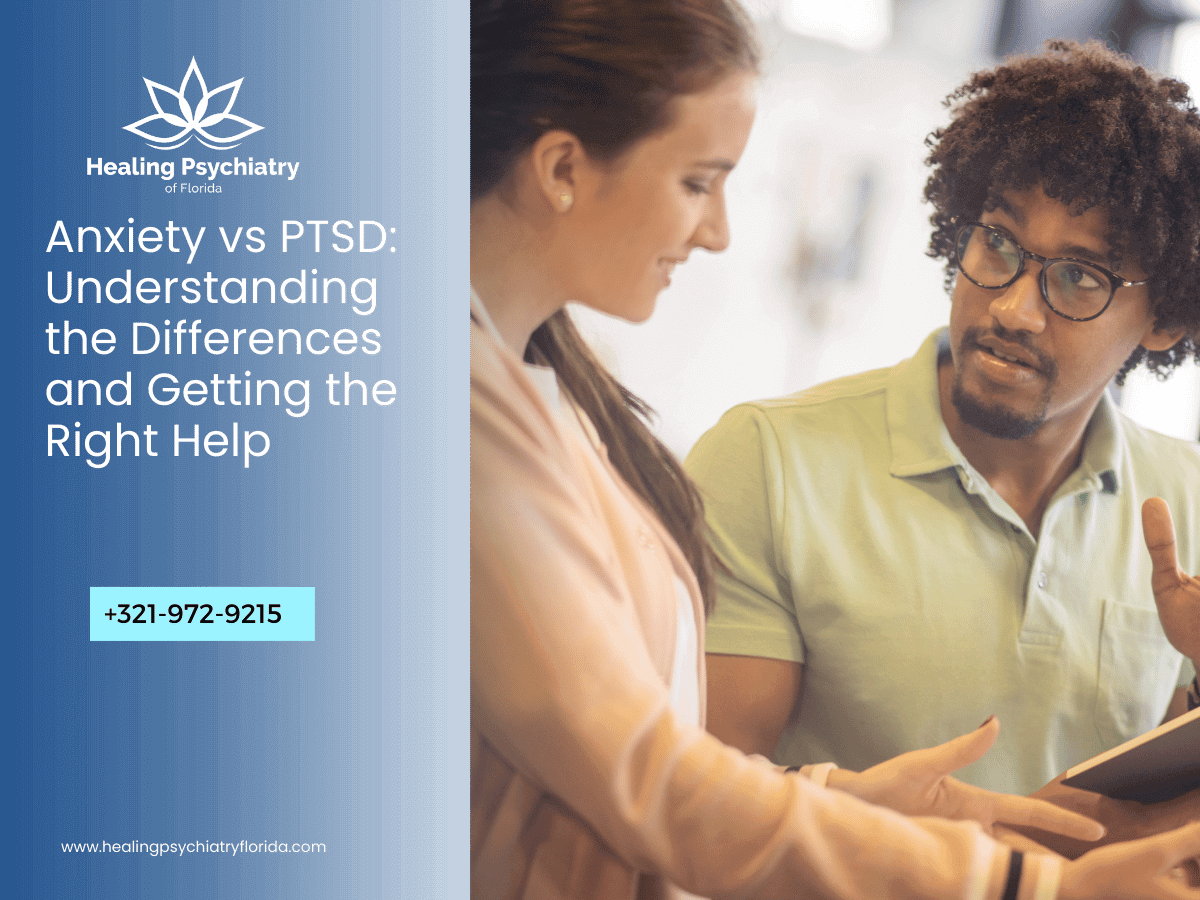Imagine a person, haunted by a past trauma. They live in fear. Another, anxious about daily situations. Both could find themselves asking, “Am I dealing with anxiety or PTSD?” This kind of confusion is very common. Over 40 million adults in the U.S. (19.1%) have an anxiety disorder. At the same time, About 6 of every 100 people will experience PTSD at some point in their lifetime according to the National Center for PTSD, a U.S. Department of Veterans Affairs program.
Anxiety and PTSD often share similar symptoms, which can make it tricky to tell them apart. Many people experience fear, avoidance, and intrusive thoughts, found in both conditions. Without a proper diagnosis and the right treatment, it’s tough to cope with either condition.
Anxiety and PTSD affect nearly every part of life. They harm personal relationships and even job performance. Many people feel alone or misunderstood because their challenges often go unnoticed by others. This guide will clarify the differences between anxiety and PTSD. With it, you can find the right support and treatment for a better life.
Understanding Anxiety
People dealing with anxiety often experience ongoing and intense worry about different life elements. This leads to physical reactions like restlessness, a rapid heartbeat, and sweating. In the U.S., anxiety disorders are very common. They include generalized anxiety disorder (GAD), panic disorder, and social anxiety disorder.
Many patients share that living with anxiety feels like being in a constant state of alert, always waiting for something bad to happen. This ongoing worry is exhausting and disrupts daily living. Over 40 million adults in the U.S. experience anxiety disorders each year.
Understanding PTSD
After a traumatic event, like a car accident or a natural disaster, individuals may develop Post-Traumatic Stress Disorder (PTSD). Symptoms often show as flashbacks, nightmares, anxiety, and racing thoughts about the event.
Some feel like they’re reliving the worst day of their life over and over. No matter how much time passes, the memories are just as vivid and terrifying. About 8 million U.S. adults have PTSD during a given year.

Key Differences Between Anxiety and PTSD
Anxiety and PTSD have some symptoms in common, but they are separate conditions with their own unique traits. Let’s take a look at a comparison to highlight these differences:
Anxiety:
- Excessive Worry: People with anxiety often worry a lot about life, from work to relationships.
- Physical Symptoms: Anxiety can cause a racing heart, sweating, and trembling. It can also cause shortness of breath.
- Sleep Disturbances: Ongoing worries make it difficult to fall or even stay asleep.
- Concentration Issues: Anxiety distracts the mind with fears. This makes it harder to focus.
- Avoidance Behavior: People may avoid situations that could trigger their anxiety.
PTSD:
- Flashbacks: A hallmark of PTSD is recurrent, intrusive memories of the traumatic event.
- Nightmares: Disturbing dreams related to the trauma are common in PTSD.
- Hypervigilance: PTSD sufferers often feel on edge, always on the lookout for danger.
- Emotional Numbness: Some with PTSD may feel numb or detached. It’s a way to cope with the trauma.
- Avoidance of Trauma Reminders: People with PTSD often avoid things that remind them of the trauma.
Example Comparison:
- Anxiety: Imagine a person who is always anxious about the future, like an important work presentation. This anxiety robs them of sleep and distracts them all day. It may even make them avoid stress-inducing situations.
- PTSD: Now, consider someone who survived a car accident. They might relive the event every time they get behind the wheel, experiencing flashbacks and intense fear. They might avoid driving altogether to escape these overwhelming feelings.
Knowing the differences between anxiety and PTSD is fundamental to getting the right kind of treatment. If someone is misdiagnosed, they might receive care that doesn’t help and could suffer longer. For example, treatments that are effective for generalized anxiety may not address the particular needs of a person with PTSD.
Similarities Between Anxiety and PTSD
Anxiety and PTSD are very different conditions. But, they do share some symptoms. This makes it hard to tell them apart. Here are some of those similarities:
- Restlessness:
- Anxiety: People with anxiety often feel a constant unease. They can’t relax and feel restless.
- PTSD: Those with PTSD may also feel restless when reminded of the trauma.
- Difficulty Concentrating:
- Anxiety: Concentration issues in anxiety come from constant worries that distract the mind.
- PTSD: PTSD will make it hard to concentrate because of intrusive thoughts or traumatic memories.
- Impaired Sleep:
- Anxiety: Causes trouble sleeping because of constant worries.
- PTSD: Sleep disturbances in PTSD often involve nightmares or insomnia related to the traumatic event.
- Emotional Dysregulation:
- Anxiety: People with anxiety may have strong emotional reactions triggered by their fears.
- PTSD: Emotional outbursts or feelings of numbness are common in PTSD as a response to trauma.
It’s important to know the similarities between these conditions. Their treatments are not identical. A proper diagnosis allows for a custom treatment plan. It will target the root causes of the symptoms.

Diagnosis and Assessment
Diagnosing anxiety involves looking at symptoms and matching them to criteria like those in the DSM-5. For PTSD, the process includes clinical interviews, trauma assessments, and sometimes neuropsychological testing. A proper diagnosis is necessary for effective treatment. It requires a thorough evaluation by a skilled professional.
Treatment Options:
For Anxiety:
- Cognitive-Behavioral Therapy (CBT): CBT’s goal is to challenge the negative thoughts that cause anxiety. This therapy teaches people to replace anxious thoughts with calming, realistic ones. It reduces anxiety.
Example: A person with social anxiety might practice positive self-talk and gradually expose themselves to social situations to build confidence. - Lifestyle Changes: To manage anxiety, stay active, eat a balanced diet, and practice mindfulness. Physical activity lowers stress hormones and boosts endorphins. Mindfulness techniques help people stay centered and less affected by anxiety.
Example: Practicing mindfulness daily can help a person with anxiety feel more centered and less overwhelmed by stressors. - Medications (SSRIs): Often prescribed for anxiety, Selective Serotonin Reuptake Inhibitors (SSRIs) help by increasing serotonin levels in the brain. This boost can improve mood and help reduce anxiety symptoms.
For PTSD:
- Trauma-Focused Therapy: This type of therapy is designed to tackle the effects of trauma on individuals. Common techniques include Cognitive Processing Therapy (CPT), Prolonged Exposure Therapy (PE), and Eye Movement Desensitization and Reprocessing (EMDR).
Example: Through EMDR, a person might process traumatic memories in a way that reduces their emotional intensity and distress. - Support Groups: Connecting with those who share similar traumas can be healing. Support groups provide a safe space for people to share their journeys and learn from each other’s coping strategies .
Example: A PTSD survivor might find comfort in hearing how others have successfully managed their symptoms. - Medications: SSRIs may help by boosting mood.
Living with Anxiety and PTSD
Managing anxiety or PTSD leads to personal growth. With the right approaches and support, you will create a life that is joyful and meaningful. Imagine waking up each day, feeling empowered and free of your past. You are excited to face whatever comes your way, with confidence.
For Anxiety:
- Mindfulness Practices: Add mindfulness activities, like meditation or deep breathing, to your daily schedule. They will help you stay balanced and reduce overthinking. Even a brief 10-minute session of mindful breathing each day makes a big difference in reducing anxiety.
- Exercise: Staying active on a regular basis is a fantastic strategy for managing anxiety. It helps release endorphins that elevate your mood. A simple 30-minute brisk walk can work wonders in alleviating anxiety symptoms.
- Balanced Diet: A diet rich in fruits, vegetables, and whole grains boost your mental health. Cutting back on caffeine and sugar can also contribute to a more stable mood.
For PTSD:
- Grounding Techniques: When flashbacks or intense emotions hit, grounding exercises help you remain in the here and now. You might find that deep breathing, concentrating on what you can feel, or holding a comforting object will really help you regain your focus.
- Routine Building: Having a daily routine brings a sense of stability and control, which is important for people coping with PTSD. Activities like going for a morning stroll or journaling also help form a reassuring structure in their day.
- Journaling: Writing your experiences and feelings can heal trauma and reflect on your journey. Journaling creates a safe space to examine your thoughts and feelings, without judgment.
Get Professional Help
If you’re facing challenges with anxiety or PTSD, Healing Psychiatry of Florida is ready to support you. Our skilled team is committed to creating tailored treatment plans that fit your individual needs. We provide various services, such as therapy, support groups, and holistic approaches, to assist you in taking back control of your life.
Conclusion
Anxiety and PTSD may share some symptoms. But, they are different conditions. They require accurate diagnosis and tailored treatment plans. Recognizing the signs and getting professional help is the first step toward a brighter and more manageable future.
At Healing Psychiatry of Florida, we are committed to offering the expert care and support you need to deal with these challenges. With the right strategies and guidance, you will manage anxiety and PTSD, leading you on a journey toward a more balanced, fulfilling life.
If you or someone close to you is experiencing these symptoms, please don’t hesitate to reach out. Our supportive team will help you every step of the way. We will make sure you get the care and support you deserve for your well-being. Embrace the chance for positive change—get in touch with us today to start your journey toward improved mental health.
For more information or to schedule a consultation, contact us at +13219729215 or visit our website.

